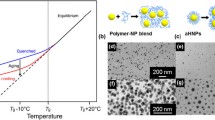Abstract
The incorporation of silica nanoparticles into polyethylene has been shown to increase the breakdown strength significantly compared to composites with micron scale fillers. Additionally, the voltage endurance of the nanocomposites is two orders of magnitude higher than that of the base polymer. The most significant difference between micron-scale and nano-scale fillers is the large interfacial area in nanocomposites. Because the interfacial region (interaction zone) is likely to be pivotal in controlling properties, this paper compares the behavior of nanoscale silica/cross-linked low density polyethylene nanocomposites with several silica surface treatments. In addition to breakdown strength and voltage endurance, dielectric spectroscopy, absorption current measurements, and thermally stimulated current determinations (TSC) were performed to elucidate the role of the interface. It was found that a reduction in the mobility in nanocomposites as well as a change in the defect size may be key to explaining the improvement in the properties.










Similar content being viewed by others
References
Nelson J, Fothergill JC (2004) Nanotechnology 15:586
Ma D, Siegel RW, Hong JI, Schadler LS, Mårtensson E, Önneby C (2004) J Mater Res 19(3):857
Nelson JK, Hu Y (2005) J Phys D (Appl Phys) 38:213
Nelson JK, Fothergill JC, Dissado LA, Peasgood W (2002) In: Proceedings of the conference on Elec Insul & Dielec Phenom, IEEE, Mexico, pp 295–298
Montanari GC, Fabiani D, Palmieri F, Kaempfer D, Thomann R, Mulhaupt R (2004) IEEE Trans Diel Elect Insul 11(5):754
Ajayan PM, Braun PV, Schadler LS (2003) In: Nanocomposite Science and Technology, Wiley-VCH Verlag, GmbH&Co. KgaA, Weinham
Tanaka T, Montanari GC, Mülhaupt R (2004) IEEE Trans Diel Elect Insul 11/5:763
Lewis TJ (1994) IEEE Trans Diel Elect Insul 1:812
Lewis TJ (2004) IEEE Trans Diel Elect Insul 11:739
Fujita F, Ruike M, Baba M (1996) Conference record of the 1996. IEEE Intl Symp Elec Ins, IEEE, San Francisco 2:738
Khalil MS, Henk PO, Henriksen M (1990) Conference record of the 1990 IEEE International Symp on Elec. Insul; IEEE, Montreal, Canada, p 268
Fothergill JC, Nelson JK, Fu M (2004) Proceedings of the IEEE Conf on Elect Insul & Diel Phenom, CEIDP, Oct. 17–20. pp 406–409
Ma D, Akpalu YA, Li Y, Siegel RW, Schadler LS (2005) J Polym Sci Part B Polym Phys 43(5):463
Malec D, Truong H, Essolbi R, Hoand TG (1998) IEEE Trans Diel Elect Insul 5/2:301
Roy M, Nelson JK, MacCrone RK, Schadler LS, Reed CW, Keefe R, Zenger W (2005) IEEE Trans Diel Elect Insul 12:629
Lunsford JH (1973) Catal Rev 8(1):135
Canet D (1996) Nuclear magnetic resonance: concepts and methods. John Wiley & Sons Inc., Chichester, New York
Dissado LA, Fothergill JC (1992) Electrical degradation and breakdown in polymers. Peter Peregrinus Ltd
Ieda M, Mizutani T, Suzuoki Y (1980) Polymers, Memoirs of the Faculty of Engineering, Nagoya University, 32/2
Peacock JA (2000) Handbook of polyethylene: structures, properties and applications. Marcel Dekker, New York
Lichtenecker K, Rother K (1931) Phys Zeit 32:255
Maxwell-Ganet JC (1904) Philos Trans Roy Soc Lond Ser A 203:385
Landau LD, Lifshitz EM (1984) Electrodynamics of continuous media, 2nd edn. Pergamon Press, Oxford
Jonscher AK (1983) Dielectric relaxation of solids. Chelsea Dielectric Press
O’Konski J (1960) J Phys Chem 64:605
Maeta S, Sakaguchi K (1980) Jpn J Appl Phys 19/3:519
Van Turnhout J (1975) Thermally stimulated discharge for polymer electrets. Elsevier, Amsterdam
Raju GG (2003) Dielectrics in electric fields. Marcel Dekker, New York
Many A, Rakavy G (1962) Theory of transient-space-charge-limited currents in solids in the presence of trapping. Phys Rev 126/6:1980
Roy M, Nelson JK, Schadler LS, Zou C, Fothergill JC (2005) Ann Rep conf on Electrical Insulation and Dielectric Phenomenon, IEEE, pp 183–186
Artbauer J (1996) J Phys D Appl Phys 29:446
Acknowledgements
The authors are grateful to the Electric Power Research Institute for the support of this activity and to Professor Fothergill’s research group at the University of Leicester, UK for the contribution of pulsed electroacoustic measurements. Discussions with Dr. Clive Reed on the chemical aspects of this work are also gratefully acknowledged.
Author information
Authors and Affiliations
Corresponding author
Rights and permissions
About this article
Cite this article
Roy, M., Nelson, J.K., MacCrone, R.K. et al. Candidate mechanisms controlling the electrical characteristics of silica/XLPE nanodielectrics. J Mater Sci 42, 3789–3799 (2007). https://doi.org/10.1007/s10853-006-0413-0
Received:
Accepted:
Published:
Issue Date:
DOI: https://doi.org/10.1007/s10853-006-0413-0




